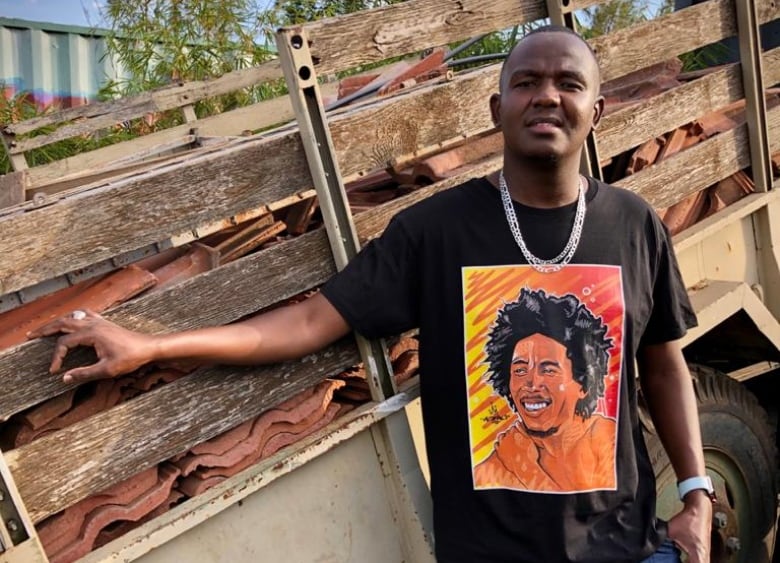Faded, defaced, but not forgotten - George Floyd murals and their social impact
Artists describe what’s changed since they painted powerful calls for action in their communities
This story is part of a CBC News exploration of systemic racism, including anti-Black racism, and the promises for change made last summer.
As the call to address and end systemic racism roared across the world last summer, a towering figure watched from the walls. It was George Floyd.
His face — not the one seen on video pleading for his life for nearly five minutes as former Minneapolis police officer Derek Chauvin murdered him, but instead that stoic, slightly smiling selfie — was everywhere. Artists interpreted that image and the words "Black Lives Matter" to create beacons where people rallied, reflected and reckoned.
CBC's The National spoke to some of the artists behind those murals a year after Floyd's death, and asked what change, if any, their work has inspired.
Daniel Anguilu, Houston

Three times Daniel Anguilu has seen his mural defaced. And three times he's gone back to fix it.
"I've considered painting over it, actually," Anguilu said, laughing slightly. "Just because I feel like it's a lot of work for me to go out there and clean it all the time. But at the same time, people care about it now."
Despite those few moments of hate, Anguilu says he has regularly seen people lay flowers and candles at the wall in Central Houston, the city Floyd grew up in.
And in what Anguilu sees as a surprising change in attitude, people in power have spoken out in its defence.
"We've had the chief of police come out and actually stand in front of it," Anguilu recalled after the third defacement this past April, where the n-word was scrawled over Floyd's face. Prior to that, another vandal sprayed "KKK" on the mural.
WATCH | Daniel Anguilu talks about repairing his George Floyd mural in Houston after it was vandalized:
"And [he] told the community and the city that this was not going to happen on his watch. That's something that I have never experienced before, just to see the level of people with some leadership or power in the city [who] want to protect our work."
Anguilu says he draws hope from seeing his city become a place where people have used more public spaces to create art with a message.
"I think if that continues, you know, we'll have more to not let us forget what's going on around us. Murals have become part of that effort: to not let us forget what we stand for."
Allan Mwangi (Mr. Detail Seven), Nairobi

In Nairobi, Kenya, the colours have faded on the Kibera neighbourhood wall where Allan Mwangi, a graffiti artist who goes by Mr. Detail Seven, helped etch a portrait of George Floyd.
But the meaning, he says, remains.
"The message? No, it hasn't faded," Mwangi said on the phone from Nairobi. "It looks a bit old, but it's still there."
The mural, which he worked on with a fellow artist named Bankslave, has three parts. On one end, the image of Floyd's face.
"On the other side, we did another mural of police stepping over a citizen," Mwangi said, pointing to police brutality as a worldwide phenomenon.
In Kenya, specifically, activists and human rights organizations have called out abuse and excessive use of force by police for years, most recently over COVID-19 curfew tactics.
Finally, in between those two images, is a word to tie the images together.
"Haki. It's a Swahili word for justice," Mwangi said.

The social commentary has drawn people from all over Kenya to come and take photos and videos of the mural over the past year. Despite that appeal, Mwangi says his pieces aren't usually political.
"But for that particular one, we had to," Mwangi explained. "There's a saying Nina Simone wrote: It's an artist's duty to reflect the times."
Jacquie Comrie, Toronto
For Jacquie Comrie, a Toronto-based artist, the power of street art has always been about change and healing.
"Mural art has been a form of activism for decades, it's nothing new," Comrie explained. "Murals have been produced around the world to talk about politics, to talk about social issues, as a way of dialogue."
WATCH | Toronto artist Jacqueline Comrie on her tribute to George Floyd:
But as a Black woman, there was another reason she lent her mastery of colour to a street mural in Toronto's Kensington Market last summer.
"About a month before the George Floyd killing happened, I found out that I was pregnant," Comrie recalled.
"And everything hit differently for me. I started thinking, what if this were my child? How can I keep my child safe? All these thoughts and anxieties came about, and just feeling so afraid. So I felt that I needed to be present in that mural project and for my son."
Comrie used her passion for colour to contribute the "A" in the word matter.

Her work is gone now, washed and driven over by cars in the past year. Even as she painted it, Comrie noted there were those who would ride their bikes directly over it.
"Of course, it speaks volumes of the resistance and the lack of respect for the message," Comrie said.
However, she adds that she feels such reactions also prove this art is striking a chord in communities.
"I think that in a way, we're doing the work right."
WATCH | The story about George Floyd memorial murals from The National:
Watch full episodes of The National on CBC Gem, the CBC's streaming service.
For more stories about the experiences of Black Canadians — from anti-Black racism to success stories within the Black community — check out Being Black in Canada, a CBC project Black Canadians can be proud of. You can read more stories here.





